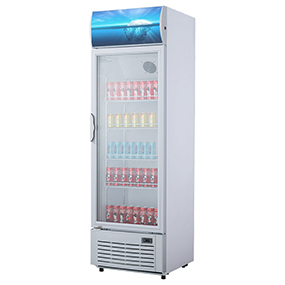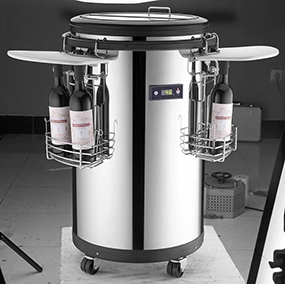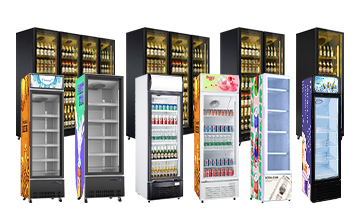Why Are Commercial Cake Cabinets Expensive? Understanding 3 Aspects of the Craftsmanship
Nov 11,2024 - 17:42 Reading:705
Why are many commercial cake cabinets so pricey? In fact, high-quality cake cabinets are of good quality and have exquisite craftsmanship, which can increase their service life and provide merchants with products of excellent craftsmanship.

The production of cake cabinets involves various crafts. The details are as follows:
I. Cabinet Structure Manufacturing Craftsmanship
Cutting Craftsmanship
For the cabinet frame of a cake cabinet, metal materials (such as stainless steel or aluminum alloy) are usually adopted. Firstly, cutting is required. According to the designed dimensions, high-precision cutting equipment such as laser cutting machines or CNC cutting machines is used. Laser cutting can accurately cut out various shapes with smooth cuts and a small heat-affected zone, making it suitable for cutting metal sheets like stainless steel to ensure the dimensional accuracy of the cabinet frame. For example, when making the frame of a square cake cabinet, the cutting equipment can cut the stainless steel sheet according to the precise length and angle, with the error being controllable within a very small range, thus providing a good foundation for subsequent assembly.
Welding Craftsmanship
The cut metal frame components need to be welded. In the production of cake cabinets, the commonly used welding method is argon arc welding. Argon arc welding can provide high-quality welded joints. During the welding process, argon gas is used as a shielding gas to prevent the oxidation of the weld seam, making the appearance of the weld seam smooth and firm. For stainless steel frames, argon arc welding can ensure that the corrosion resistance of the welded parts is the same as that of the overall material. Welding workers need to strictly follow the welding process specifications, control parameters such as welding current, speed, and argon gas flow to ensure that the weld seams are uniform and free of defects such as pores and cracks.
Bending Craftsmanship
Some side panels or door panels of the cake cabinet may need to be bent to form specific shapes. This requires the use of a bending machine to operate according to the designed angles and curvatures. During the bending process, the thickness and ductility of the material need to be considered, and appropriate bending molds and pressures should be selected. For example, when making the glass display cabinet door with a curvature, through the precise bending craftsmanship, the metal frame can perfectly fit the glass and ensure the strength of the frame to prevent deformation.
II. Insulation Layer Manufacturing Craftsmanship
Insulation Material Selection
Cake cabinets require good insulation performance. Commonly used insulation materials include polyurethane foam. This material has excellent insulation performance, a low thermal conductivity coefficient, and good moisture resistance. When selecting polyurethane foam, its density and quality should be considered. Generally, polyurethane foam with a density of 30 - 50 kg/m³ is more suitable for the insulation of cake cabinets.
Pouring Craftsmanship
The production of the insulation layer usually adopts the pouring method. After the cabinet frame is assembled, the prepared polyurethane foam raw materials are injected into the interlayer of the cabinet through special pouring equipment. During the pouring process, it is necessary to ensure that the foam is evenly filled to avoid the occurrence of cavities or local uneven density. After pouring, the foam will expand and solidify in the interlayer to form a continuous insulation layer. This process requires strict control of the pouring amount, pouring speed, as well as environmental temperature and humidity, because these factors will affect the solidification effect and insulation performance of the foam.
III. Refrigeration System Installation Craftsmanship
Compressor Installation
The compressor is the core component of the cake cabinet's refrigeration system. When installing the compressor, an appropriate installation location should be selected. Usually, it is installed in a well-ventilated position at the bottom of the cabinet to ensure that the compressor has good heat dissipation conditions. During the installation process, it is necessary to ensure that the compressor is firmly installed. Measures such as shock-absorbing pads are used to reduce the vibration and noise during the operation of the compressor. At the same time, the suction pipe and exhaust pipe of the compressor should be correctly connected, and the connection parts should be well sealed to prevent refrigerant leakage.
Evaporator and Condenser Installation
The evaporator is generally installed inside the cake cabinet to absorb heat through heat exchange with the air and lower the temperature inside the cabinet. The installation of the evaporator should ensure good heat conduction with the inside of the cabinet. Usually, fins are installed on the surface of the evaporator to increase the heat exchange area. The condenser is installed on the back or side of the cabinet to dissipate heat to the outside. When installing, it is necessary to ensure that the condenser has sufficient ventilation space to avoid heat accumulation and affect the refrigeration effect. The evaporator and condenser are connected by copper pipes. The bending and connection of the copper pipes should meet the requirements of the refrigeration system to ensure that the refrigerant can circulate smoothly.
Refrigerant Charging
After the installation of the refrigeration system is completed, refrigerant charging is required. The charging amount of the refrigerant should be accurately calculated according to the refrigeration capacity of the cake cabinet and the requirements of the system. When charging the refrigerant, professional charging equipment should be used to slowly inject the refrigerant into the refrigeration system through the high and low pressure interfaces. During the charging process, the pressure change of the system should be closely observed to ensure that the charging amount of the refrigerant is accurate. Too much or too little refrigerant charging will affect the refrigeration effect and operation stability of the cake cabinet.
IV. Display Part Manufacturing Craftsmanship
Glass Installation
The display part of the cake cabinet usually adopts glass materials such as tempered glass. When installing the glass, it is necessary to ensure that the size of the glass precisely matches the opening size of the cabinet. Firstly, a sealing rubber strip is installed at the opening of the cabinet. The rubber strip has good elasticity and sealing performance and can prevent the leakage of cold air. Then the glass is carefully placed into the opening and fixed by means of card slots or glue. For large glass display surfaces, a multi-point fixing method may be required to ensure the stability of the glass during use.
Lighting System Installation
To better display cakes, a lighting system is usually installed inside the cake cabinet. The lighting system generally adopts LED lights because LED lights have the advantages of high brightness, low energy consumption, and long service life. When installing LED lights, the positions of the lamps should be reasonably arranged to ensure that the light in the cake display area is uniform and free of shadows. The lamps are usually installed on the top or side inside the cabinet and connected to the power supply through wires. The wires should be hidden in the wire grooves inside the cabinet to ensure the neat appearance of the cabinet. At the same time, attention should be paid to the waterproof and moisture-proof of the lamps to avoid damage to the lamps due to water vapor entry.
Popular item
-

Mega Top Pizza Prep Table Refrigerator with Pan Rail Top 60″ Inch
(5) -

Cheapest Smallest Fridge Countertop with Glass Door 4 Gallon SC15
(5) -

Cheapest Smallest Cooler Countertop with Glass Door 6 Gallon SC25
(5) -

Cheapest Smallest Refrigerator Countertop with Glass Door 6 Gallon SC35
(5) -

Top Freezer Display Fridge Freezer with Glass Door 55L 1.9 Cu Ft
(5) -

Big Glass Door Kitchen Freezer Side by Side with Auto Defrost 1000 Liters
(5) -

Grocery Store Swing Door Visi Merchandiser with Clear Front
(5) -

Supermarket Horizontal Open Swing Door Merchandiser Refrigerator
(5) -

Vertical Upright Fridge Built in Freezer Fridge 200L 7 Cu Ft
(5) -

Glass Swing Door Cooler Ventilated Cooling 0–10℃ 268 Litre
(5) -

Small Display Merchandiser Cooler with Clear Front 335 Litres
(5) -

Mini Cooler Fridge with Self-Closing Door 105 Litres
(5) -

Small Refrigerator with Slimline Design with Glass Door 135L
(5) -

Small Beverage Cooler with Transparent Door 145 Litres
(5) -

Small Drink Fridge with Glass Door and Led Lights 350L
(5) -

Small Drink Fridge with Glass Door 0–10℃ 310 Liters
(5) -

Stainless Steel Barrel Cooler Mini Bar Fridge for Wine and Beverage
(5) -

Round Pepsi Cooler Freestanding with Top Open Cover
(5) -

Mini Round Topo Chico Cooler Small Barrel Shape Upright
(5) -

Outdoor Mobile Round coke Cooler for Party event Marketing
(5)

































